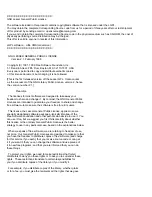
Chapter 9. The GRUB Boot Loader
94
3.
The Stage 2 or secondary boot loader is read into memory.
The secondary boot loader displays
the GRUB menu and command environment. This interface allows the user to select which kernel
or operating system to boot, pass arguments to the kernel, or look at system parameters.
4.
The secondary boot loader reads the operating system or kernel as well as the contents of
/
boot/sysroot/
into memory.
Once GRUB determines which operating system or kernel to start,
it loads it into memory and transfers control of the machine to that operating system.
The method used to boot Red Hat Enterprise Linux is called
direct loading
because the boot loader
loads the operating system directly. There is no intermediary between the boot loader and the kernel.
The boot process used by other operating systems may differ. For example, the Microsoft
®
Windows
®
operating system, as well as other operating systems, are loaded using
chain loading
. Under this
method, the MBR points to the first sector of the partition holding the operating system, where it finds
the files necessary to actually boot that operating system.
GRUB supports both direct and chain loading boot methods, allowing it to boot almost any operating
system.
Warning
During installation, Microsoft's DOS and Windows installation programs completely
overwrite the MBR, destroying any existing boot loaders. If creating a dual-boot system, it
is best to install the Microsoft operating system first.
9.2.2. Features of GRUB
GRUB contains several features that make it preferable to other boot loaders available for the x86
architecture. Below is a partial list of some of the more important features:
•
GRUB provides a true command-based, pre-OS environment on x86 machines.
This feature
affords the user maximum flexibility in loading operating systems with specified options or gathering
information about the system. For years, many non-x86 architectures have employed pre-OS
environments that allow system booting from a command line.
•
GRUB supports Logical Block Addressing (LBA) mode.
LBA places the addressing conversion used
to find files in the hard drive's firmware, and is used on many IDE and all SCSI hard devices. Before
LBA, boot loaders could encounter the 1024-cylinder BIOS limitation, where the BIOS could not find
a file after the 1024 cylinder head of the disk. LBA support allows GRUB to boot operating systems
from partitions beyond the 1024-cylinder limit, so long as the system BIOS supports LBA mode.
Most modern BIOS revisions support LBA mode.
•
GRUB can read ext2 partitions.
This functionality allows GRUB to access its configuration file,
/
boot/grub/grub.conf
, every time the system boots, eliminating the need for the user to write
a new version of the first stage boot loader to the MBR when configuration changes are made.
The only time a user needs to reinstall GRUB on the MBR is if the physical location of the
/boot/
partition is moved on the disk. For details on installing GRUB to the MBR, refer to
Section 9.3,
“Installing GRUB”
.
Summary of Contents for ENTERPRISE LINUX 5 - VIRTUAL SERVER ADMINISTRATION
Page 12: ...xii ...
Page 20: ......
Page 30: ...12 ...
Page 32: ...14 ...
Page 82: ...64 ...
Page 106: ...88 ...
Page 122: ...104 ...
Page 124: ...106 ...
Page 126: ......
Page 132: ...114 ...
Page 168: ...150 ...
Page 182: ...164 ...
Page 192: ...174 ...
Page 194: ......
Page 236: ...218 ...
Page 238: ...220 ...
Page 270: ......
Page 274: ...256 ...
Page 278: ...260 ...
Page 292: ...274 ...
Page 294: ......
Page 300: ...282 ...
Page 304: ......
Page 316: ...298 ...
Page 370: ...352 ...
Page 384: ...366 ...
Page 385: ...Part VII Appendix ...
Page 386: ......
















































